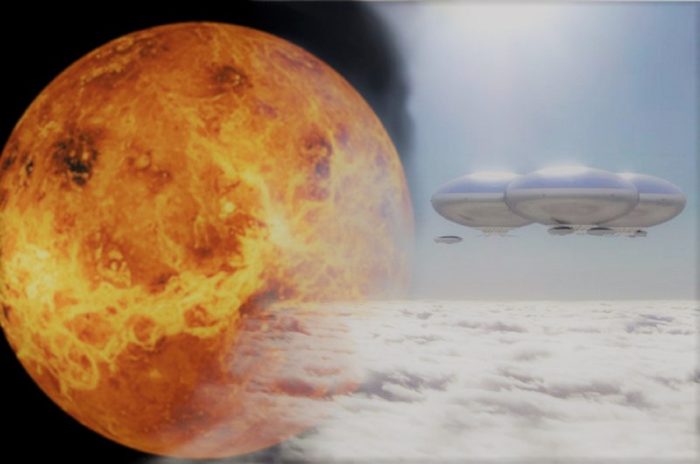
Cloud Cities On Venus: Exploring Earth’s Forgotten Cosmic Neighbor!
- By
- October 18, 2018
- September 28, 2021
- 16 min read
- Expert Opinion
- 1
- Posted in
- Space, Future Exploration
Right from the dawn of science-fiction, and again during the first wave of UFO popularity in the 1950s, along with Mars our other neighboring planet, Venus, was seen as the obvious place where alien life would exist. And where humans would surely visit. In fact, the Soviet space program did manage to land a probe on Venus as early as the mid-1960s. In part, it is because of the Soviet missions, as well as the continued and advanced monitoring of the planet, that we know that life, at least how we understand it, simply can’t survive there.

Venus blended into a depiction showing potential floating cloud cities
However, also as far back as the 1950s, many UFO researchers were theorizing that perhaps colonies might be able to survive high up in the thick clouds of the planet. Or that huge spaceships or “floating cities” might be able to support life and establish an aerial colony of sorts? It seems such a notion is not at all as outlandish as it first sounds, with NASA recently stating their desire to achieve such floating bases on our often-forgotten cosmic neighbor.
Might it even be that an extraterrestrial civilization, either now or in the not too distant past, have already achieved such a colony? It is perhaps interesting that several people who had close-contact encounters would claim similar things. And, while the aforementioned Soviet mission to Venus didn’t discover alien life, there were some interesting anomalies picked up in the few pictures that they did send back.
We will look at NASA’s future plans shortly. First, though, we will quickly examine the first visions of Venus sent back courtesy of the Venera missions. Before we get started, however, check out the short video below. What would it be like to stand on Venus?
Contents
- 1 Venus – A Constant Source Of Fascination
- 2 Soviet Probe To The Second Planet From The Sun – The Venera Missions
- 3 Bizarre Claims Of The Venusians!
- 4 NASA’s Plans For Floating Airships On Venus
- 5 Making Money From Our Planetary Neighbor?
- 6 Might Research Airships Become Commercial Floating Mini-Cities?
- 7 An Astonishing Recent Discovery
- 8 Should We Look Again At Apparent Lifeless Planets?
- 9 Expert Opinion
Venus – A Constant Source Of Fascination
Venus has not only been revered by multiple civilizations around the world, as well as treated as a deity by many of those, from a scientific and space exploration point of view, our closest planetary neighbor is a fascinating place. And what’s more, it very well could have had an even more fascinating past.
For example, many scientists believe that millions of years ago – perhaps longer than that – Venus could have been very much like Earth.
There are also some very intriguing details and facts about Venus. For example, while it only takes around seven and a half months for Venus to complete a full orbit of the Sun (224.65 days to be exact), the day-night cycle is such that it takes almost eight months for the planet to complete one complete rotation. An even further intriguing detail is that the planet spins in the opposite direction to Earth. This means on Venus, the sun will rise in the west and set again in the east – and we should remember that following that sunrise in the west, you will be stuck with your solar friend for eight months.
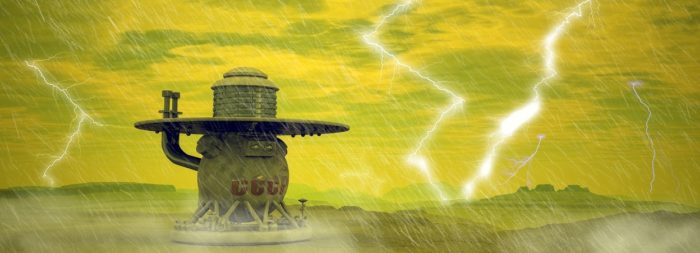
A dramatic drawing of a Soviet space probe on Venus
What we know of our cosmic neighbor is largely down to numerous flyby missions of Venus, and several partially successful landings of probes. Indeed, perhaps because of the limited surface pictures we have of Venus it appears to many of us even more of an alien world than Mars does. Indeed, it might be this limited number of pictures by comparison to our red neighbor that makes Venus all the more enticing.
Of all the missions, though, some of the most intriguing – despite their limited success – were the Venera Missions by the Soviet Union.
Soviet Probe To The Second Planet From The Sun – The Venera Missions
Beginning in 1961, the Soviet Union would launch the first Venera probes [1] to obtain data and information about the planet Venus. While each of these probes and launches were of varying degrees of success, it wasn’t until the third mission on 1st March 1966 – ten years before the Mars Viking mission and three years before the Moon landings – when the Soviet’s Venera 3 became the first object made by humans to land on another planet, albeit a crash landing, which sent back no useable data.
However, as the missions continued, successful landings were achieved. And what’s more, valuable information taken during descent and from the planet’s surface reached Soviet scientists back on Earth. Undoubtedly the most exciting of the Venera missions were those from 1975 and the Venera 9 onwards, which would not only manage to send back data but the first photographs of the planet.
By 1982 and the Venera 13 mission, the first color photographs were sent back, as well as the first audible recording from the planet’s surface. Many of the color photographs would spark controversy and conspiracy. Many eagle-eyed viewers of them would spot what appeared to be a disc on the surface as well as other “mechanical debris”. The official view is that this was simply debris from the probe itself. However, the apparent “scorpion-like creature” seen in another part of the shot is perhaps less easy to explain away.
The short videos below are both worth watching. The first speaks of the Soviet Venera missions to Venus and shows some of the pictures taken. The second looks at some of the apparent anomalies and what they might be.
Bizarre Claims Of The Venusians!
While we will not spend too much time on them here, there are several encounters are on record of individuals claiming to have had close-contact events with aliens from Venus.
Perhaps one of the most intriguing were those of Albert Coe, who would claim a life-time friendship with a Venusian. Stretching over several decades beginning in 1920 and a chance meeting with mysterious man, who would later reveal to Coe to be part of an extraterrestrial race based on Venus. And who had been visiting Earth for thousands and thousands of years?
The incident would result in the self-published 1969 book The Shocking Truth in which Coe goes in detail about many of the conversations and the many times he would accompany “Zret” in his craft. The details, if we assume for a moment are accurate, highly support such claims as the Ancient Astronaut Theory and of “outside influence” in human history. Zret would claim that this particular mission was to “monitor Earth’s advances” and was begun in 1904. According to Coe, Zret informed him that 100 such extraterrestrial agents “infiltrated every major nation on the planet – as small groups of technicians – to observe and evaluate” humanity.
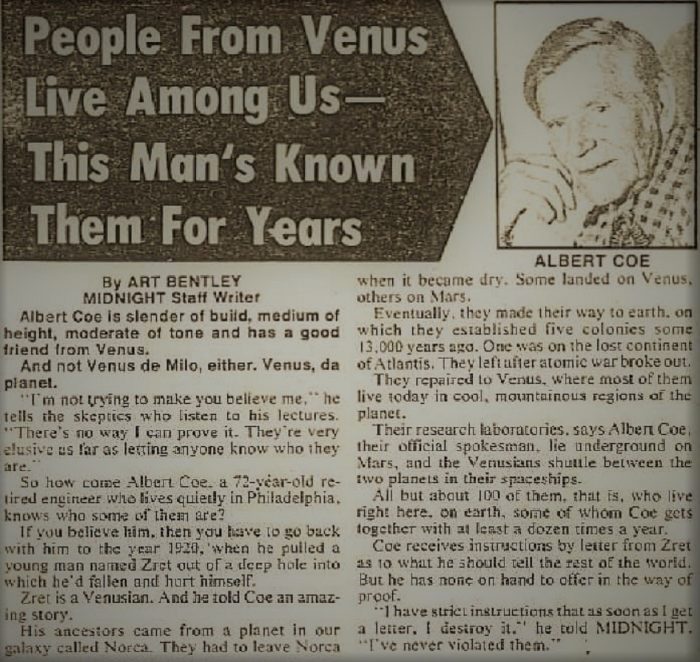
A newspaper clipping regarding the claims of Albert Coe
While many treat Coe’s claims with a rather large pinch of salt, they are intriguing, nonetheless. And perhaps, they may be proven one way or another, at least in part, should NASA achieve their desire to establish a “cloud-base” in the skies of Venus.
Indeed, in the same way we might question if astronauts who may one day discover life on Mars that has evaded us, we might ask the same about the upper atmosphere of Venus. In the very least that such an advanced space-faring civilization could indeed survive in the upper reaches of the Venusian atmosphere.
NASA’s Plans For Floating Airships On Venus
OK, so perhaps we should quickly steer our attention back [2] to the proposed cloud city missions to Venus of our contemporary era.
Although there is no specific date for the mission, which itself will rely on multiple test missions first, NASA plans to use airships to host humans in the upper atmosphere of Venus. What is perhaps exciting, despite the (likely) decades before such a mission is achieved, the technology to fulfill a High-Altitude Venus Operational Concept (HAVOC) mission is already within reach of our collective possession.
Of course, the need to stay well away from the surface of the planet is paramount. Not that we would likely survive such a trip through the thick atmosphere and crushing pressure to the metal-melting furnace-like surface of Venus. However, the altitude NASA is looking to operate in offer positively different conditions. In fact, so hospitable are they, that any onboard astronauts wouldn’t require specialized suits or breathing apparatus (providing oxygen was “made” inside the airship of course).
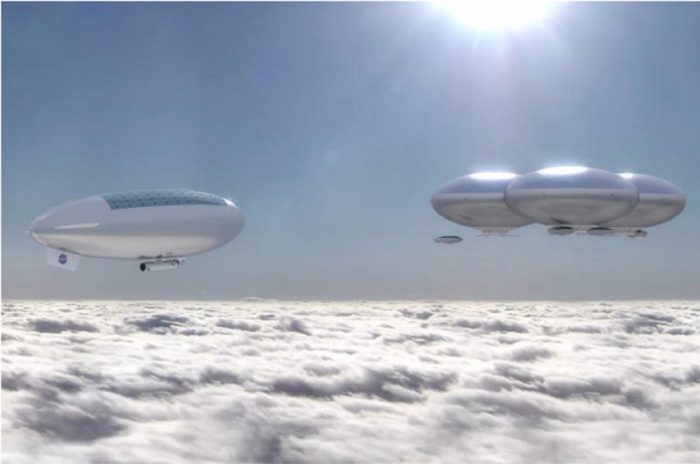
Artist’s impression of floating cloud cities in the atmosphere of Venus
The temperature and the pressure are considerably more Earth-like at an altitude of between 30 and 40 miles, even comparable to the lower atmosphere of Earth, with the pressure about half that of Earth’s at sea level. The thick atmosphere above will also offer protection from space radiation, while at the same time providing an abundance of sunlight to be converted into renewable energy.
Furthermore, due to the high presence of sulphuric acid in the atmosphere, the airships would have to have an exterior resistant to such acidic and corrosive conditions as they were blown around the planet by the Venusian winds.
Why Is Such A Mission So Important?
It is an argument often leveled at many space enthusiasts from those who couldn’t care less of what awaits beyond our planet – that such missions are a “waste of money” and we should look to “take care of Earth” and many other morally outraged-influenced arguments.
The missions, should they go ahead, will not only provide a cloud-like colony for humanity, but would also tell us a lot about the potential worst-case scenarios that await Earth should certain conditions arise here or, in some cases, if they are not dealt with now. By studying our nearest cosmic neighbor close-up, a planet that highly resembles Earth and certainly would have been considerably more Earth-like before whatever climate-driven ecological change took place, we should be able to approach any efforts to protect our planet from going the same way with a fuller more hands-on understanding of such things.
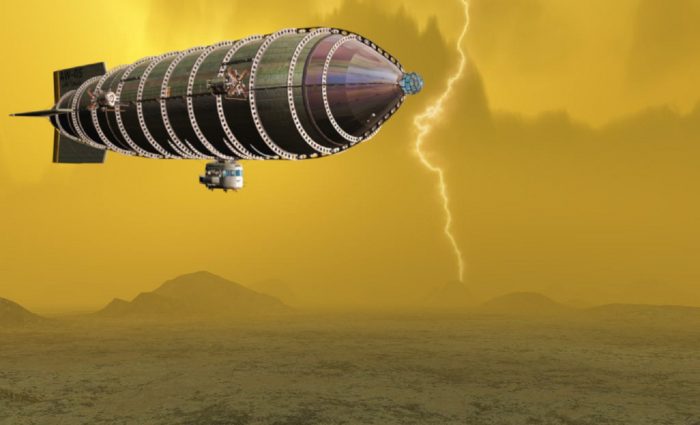
A depiction of an airship on Venus
It would also allow us to understand, and potentially witness if there is the presence of extremophiles in the atmosphere of the planet – essentially, alien life. We know here on Earth, for example, small living creatures quite happily exist in some of the most extreme and inhospitable areas of the planet, on both extremes of the temperature and conditions. Why, then, should that not be the case for Venus? Scientists already suspect similar conditions exist in some of the moons of the gas giants such as Jupiter and Saturn, for example. And while it would surely be harder to achieve, perhaps monitoring of the surface might reveal similar life?
In short, although any results and consequences of such missions to faraway worlds will not be immediately known or even visible, they might lay the foundations for how we deal with such pressing environmental problems here on Earth.
Like A Second Earth (Almost)
It is perhaps worth our time returning to the similarities between Venus and our own home planet for a moment. Perhaps the fact that it is the nearest planet to us – closer than Mars – arguably makes it the number one destination for those involved in space exploration.
If we do manage to establish a floating city high up in the clouds on Venus – or even a network of floating cities – then the conditions at that level would be almost identical to those on Earth. For example, albeit it would be in potentially large floating airships, a permanent residence in the Venusian clouds might one day be a possibility. Perhaps even, as we will explore shortly, space tourism might even develop around such advances, with private companies flying humans for a two-week break in the upper atmosphere of our closest cosmic neighbor?
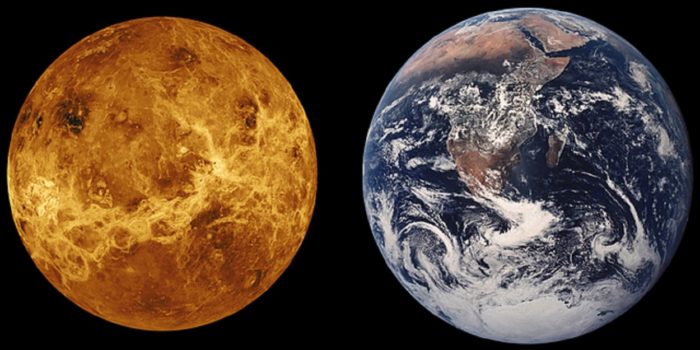
A comparison of the size of Venus compared to Earth
There are a number of things to consider with regard to the closer proximity of Venus to Earth, particularly if we are looking at such missions to provide humans with a “plan b” in terms of a collective home.
For example, while residing on the surface of Venus would still be out of the question (barring an extremely aggressive terraforming program – which we will also examine a little more shorty), it might be possible to create floating, or hovering, metropolis-like cities in the upper atmosphere – especially when we consider that Venus is almost exactly the same size as Earth, unlike Mars which is significantly smaller.
Essentially, as much of a long shot as it might be and if we remove the logistics of spaceflight for a moment, having a second home to escape to, albeit one that is floating almost 40 miles above the surface of the terrain, is perhaps reason enough to persevere with such projects.
A Three-Phase Project
The project itself is broken down [3] into three proposed phases.
The first would be to send a robotic explorer into the targeted atmosphere height. While in the atmosphere, the robotic explorer will begin research in three key areas.
For example, it will look to understand the “atmospheric formation, evolution, and climate history” of the planet. In doing this it will look to understand how the atmosphere of Venus was formed, as well as the chemical make-up of the thick clouds that envelope this upper atmosphere and what the impact on the climate might be as a result. Furthermore, it will also look to seek information about the “radioactive and dynamical energy” of the planet.
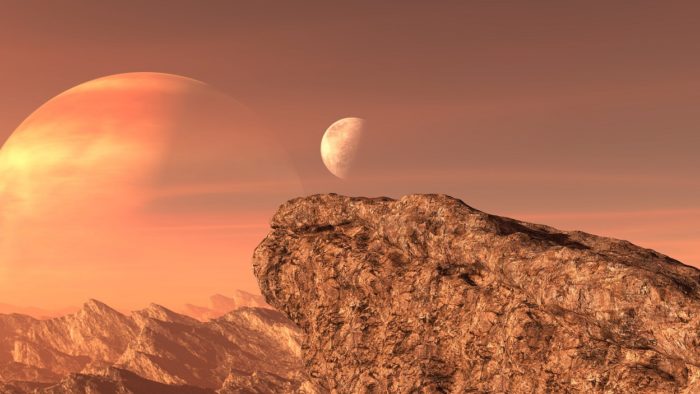
Artist’s impression of the surface of Venus
Perhaps of most importance, at least to the further phases of the mission, do these regions of the upper atmosphere harbor life?
Our robot explorer will also look to obtain information on “the nature of interior surface-atmospheric interactions” of Venus. Basically, did the planet ever contain liquid water? If so, what happened to it, and did the greenhouse effect play a role in this changing of states?
Lastly, the first phase of the mission will hope to better understand the “evolution of the surface and interior”. Perhaps not least researchers hope to better understand the overall evolution of Venus. How, for example, did it change from a habitable planet very similar to Earth to the solar system’s equivalent of Hell?
Gathering Data From The Clouds Of Venus
The second phase of the project would see the astronauts themselves put into orbit around Venus. This phase itself will require a “base” of sorts being ready for the crew when they arrive, which will mean a remote assembly of the bulk of the orbiter. Once all tests have been completed, the crew will launch toward the orbiter and dock with it where they will remain for 30 days.
Of course, the final phase of the mission would be for humans to descend into the atmosphere itself. Before the astronauts themselves make the journey, a base module would have been set up remotely for them to dock to. Even the airship in which they would spend their 30 days (at least initially) would not be inflated until the astronauts were within the planet’s atmosphere.

Artist’s impression of the surface of Venus
While the astronauts remain in orbit, further experimentation and data gathering will take place. Once complete, they will detach themselves from the airship and then ascend to the orbit of the planet where they will dock with the craft waiting to return them home back to Earth.
One advantage of establishing a “cloud city” is that the airships concerned could be placed into the wind currents which sweep across the planet, covering its entirety every four days. This would make the day-night cycle – while still double that of Earth at 48 hours – much more reasonable than the eight months a “day” lasts on Venus due to the amount of time it takes to complete a rotation.
Should the mission actually come to fruition there are a great many paths for it to venture off into? Just one of which we will turn our attention to next.
Would Surface Missions To Venus Ever Be Possible?
As it is today, any attempts for humans to land on the surface of Venus would result in their certain deaths.
Of course, we know that the Soviet Union did manage to land a probe on the surface of Venus in the 1970s. And while the information it sent back was limited, it might one day be the case that advancements in manned space vehicles might be able to take humans to or near the surface (should it be able to significantly resist the heat or crushing atmosphere). Whether those speculative advancements might extend to specialized suits to navigate the surface on foot remain open.
While there are certainly no plans to send humans to the surface in these potentially heat and pressure-resistant vehicles, there are plans [4] to send unmanned probes to the surface that could survive for several months, if not years. If such missions go ahead and prove successful, then they will yield invaluable data about not only how the planet is today, but how it might have been in the past.
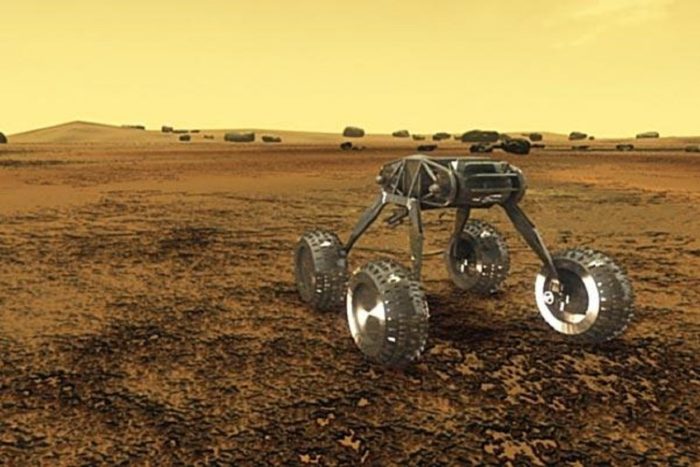
Artist’s impression of a rover exploring the surface of Venus
Indeed, if Venus was once more Earth-like in terms of habitability millions or even billions of years ago, as some scientists suspect, then understanding what happened to it and why might help us highlight the very real warning signs of a similar fate awaiting our own home planet.
Perhaps as an afterthought, while many researchers in the UFO and alternative history communities postulate that advanced civilizations might have one day existed on Mars, perhaps even arriving on Earth in the distant past following one planetary disaster or another, might it be that such a scenario occurred on Venus? It is certainly an intriguing thought.
As is the prospect of one day being able to venture down to the surface of Venus.
Might We One Day Terraform Venus?
How realistic it might be is perhaps open to debate, but there are, at least in theory, ideas in place for the potential terraforming [5] of Venus. And while the technology to do so is still out of our reach, what needs to be done is clear in many scientists’ minds.
What’s more, in theory, remember, Venus would likely appear very Earth-like should a successful terraforming program be undertaken. Not only is Venus approximately the same size as Earth, it sits well within the “Goldilocks Zone” for supporting life and has a very similar terrain (in terms of composition). This makes the planet, at least to some, more attractive than Mars with regard to such a terraforming mission.
There are three specific things that need addressing in order for this to happen, and each are connected to the other. For example, the soaring furnace-like temperatures will have to be addressed, bringing them down from over 450 degrees centigrade (around 850 degrees Fahrenheit).
Part of the reason for such hellish heat is due to the thick, dense atmosphere of the planet (around 90 times more so than Earth), which would itself need addressing in order to terraform the planet to a state that could support human life. The carbon and sulfur dioxide in the atmosphere would need to be removed, while at the same time oxygen would need to be introduced.
We should note, that barring astronomical advances in technology, such a terraforming program would take hundreds, if not thousands of years. If such a program was to go ahead it would likely do so with the knowledge that it wouldn’t be complete until a completely different era in the human timeline.
The video below looks at the possibilities of terraforming Venus a little further.
The Venusian Tower Of Babel Project
Perhaps one of the more ambitious proposals for Venus is the Tower of Babel project, which is not its official name, we should note – but a reference to the Biblical myth of the people of Babel creating a tower that could “reach heaven”.
In its most basic, stripped back form, the project aims to build huge artificial mountains that stretch high (at least 30 to 40 miles) into the clouds of Venus. On these artificial structures, permanent settlements will be able to be established.
While our colonizers would still have to remain inside these settlements (barring advancements in spacesuits), the proposal is an intriguing one.
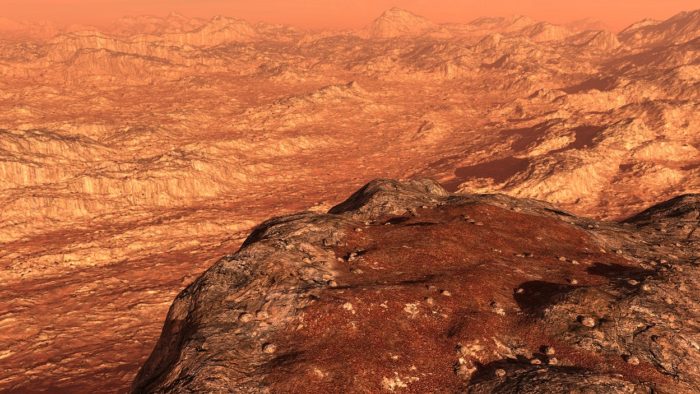
Depiction of the surface of Venus
These mountains would be built using the highly advanced and heat-resistant machines that, once on the surface, would begin gathering materials. These interplanetary bulldozers would essentially gather up and shift the raw materials of the surface and, at a preprogrammed destination on the planet, would begin the task of creating a mountain that would stretch high into the clouds overhead.
While surface missions to Venus and terraforming the planet to a state where humans could “live” there is still significantly far off, sending advanced probes and, ultimately, establishing floating cloud bases could very much occur in the near (relatively speaking) future. And possibly even settlements on artificial mountains.
There is, however, another aspect to any future missions to Venus, as well as to all of future space exploration. And, as we might expect, it revolves around money. More specifically, how much money might be made from venturing out into new worlds in space.
Making Money From Our Planetary Neighbor?
Of course, while space exploration is at the heart of missions into space, as we examined in our article looking at potential missions to Mars, the very real concept of space mining might also play a part in such missions as the decades and advancements continue.
There will undoubtedly be opportunities for ore extraction (technology permitting). And if the technology and orbiting vehicle infrastructure are already in place, these mining missions could proceed largely remotely.
For example, we have already examined the notion of sending down robots with a preprogrammed mission to create artificial mountains – miles and miles high, remember. It is perhaps not at all that much of a stretch of the imagination to think that should the idea of traveling to Venus becomes a reality, even if just in its orbit, such robots could be sent to the surface to extract relevant ore before sending it back to the upper atmosphere where it could be retrieved.
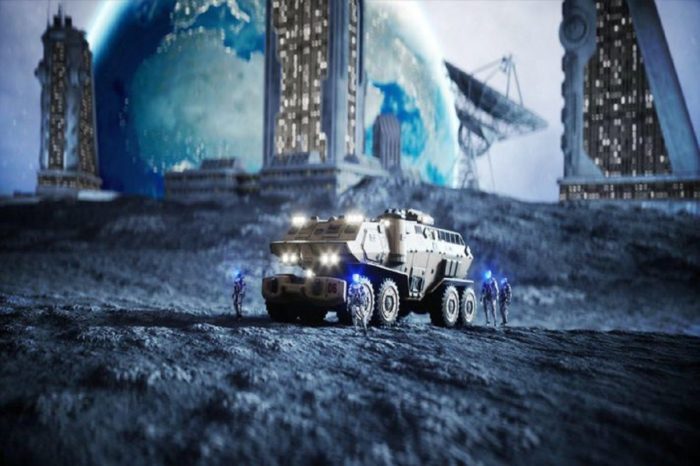
A depiction of space mining
Of course, while we are perhaps still a little in science-fiction territory here, you can bet that if there is money to be made from such potential resources on Venus, plans will be proposed to make it.
There is also another region that we should mention – space tourism. This potentially, depending on the HAVOC missions, of course, perhaps becomes a more urgent possibility with Venus. Not least as aside from the airships themselves, no hard infrastructure on the actual surface would have to be put in place. It is to this potential future industry that we will turn our attention to next. Not least, as the mining for valuable resources and space tourism are very likely to operate hand-in-hand, which in turn would intertwine them with the exploration of the planet.
Might Research Airships Become Commercial Floating Mini-Cities?
If these missions do proceed and are indeed successful, should we then expect a commercial operation to begin? Can you, for example, hope to book a month away in the floating hotels of Venus in the near future? While there are no indications from NASA of such trips, it isn’t hard to imagine. In time, surely more extravagant floating hotels and even entire floating complexes would go into operation. If there was a sound financial return. Not to mention the ability to raise further funds for other operations. Either on Venus or elsewhere.
While this is pure rampant speculation, there is nothing to stop a private company going ahead with such plans. Particularly one that might make a considerable donation to NASA, for the sake of argument. And perhaps it is worth bearing in mind, that private companies are free from Freedom Of Information requests. Again, while this is mere speculation, if there were any “secret” operations on Venus or anywhere else, it is most likely that a private company would head such an operation. At least officially.
It is interesting that several people, either through a close-contact experience with a UFO, or even through claims of traveling into the future, have made claims of similar “floating cities”. Might this be the start of such things? Might such aerial settlements tested on Venus have use on Earth to escape rapidly deteriorating surface conditions? It certainly makes for interesting, and perhaps eye-opening thinking.
Check out the short video below which looks at the proposed HAVOC mission a little more.
An Astonishing Recent Discovery
In September 2020 Venus was thrust into the mainstream news when scientists from Britain announced they had uncovered evidence of microbial life in the atmosphere of the planet. They were first alerted to the possibility by detecting phosphine, a toxic gas that such microbes produce. And despite what they could clearly see in their data, they would state that the discovery is one that shouldn’t have happened.
They would eventually rule out that the gas was being produced on the surface of Venus, meaning the only reasonable assumption was that this microbial life likely resides in the thick clouds that swirl around the planet. As we noted earlier, many researchers have suggested for some time that life might be able to survive high up in the atmosphere of Venus. And this discovery appears to corroborate those suggestions.
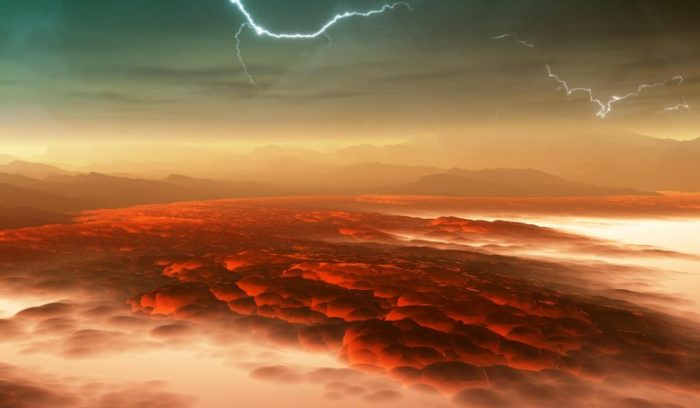
Artist’s impression of Venus viewed from the air
The discovery is exciting in particular for those looking for the existence of life elsewhere in space. While most efforts have looked (and ruled out) Mars, and there are future missions planned (in theory) to the gas giants of Jupiter and Saturn, it might be that such alien life, albeit microbial, exists a lot closer to home than we thought.
We should note, however, it is far from a foregone conclusion that the discovery of phosphine on Venus means life definitely exists there. The scientists themselves cautiously described it as an “anomalous and unexplained chemistry” and that there could, following further research, be other explanations for the find.
Should We Look Again At Apparent Lifeless Planets?
What else these findings do is open the door to the question as to just what alien life might look like. While we would certainly know the conditions to look for human life to survive, alien life might prove to be so alien that it requires drastically different conditions and elements. This thought alone should perhaps cause us to relook at worlds that we have previously dismissed.
Although it is almost a certainty that the potential microbial life discovered on Venus does reside in the thick cloud systems high in the planet’s atmosphere, it is not completely beyond the realms of possibility that similar – although drastically different in terms of genetic make-up – exists on the surface. And this, of course, could be the same for other planets – both in our solar system and much further in the reaches of the cosmos.
Might, for example, Mercury be home to such basic life that suits its harsh conditions? Might we even one day discover similar microbial life forms in the seemingly hellish clouds of Jupiter, Saturn, Uranus, or even Neptune?
Like many other fields, such discoveries in one place might prove to shine a light elsewhere, potentially creating a domino effect that will lead to more and more answers and a greater overall understanding of life outside of the Earth. And quite possibly, a greater understanding of life that exists on our own planet, how it developed and why. Like space itself, the possibilities, and indeed questions, are endless.
The video below looks at the recent findings a little further.
Expert Opinion
Discussions surrounding potential Venus outposts revolve around the planet’s dense cloud canopy, tracing back to 1950s aerial-colony theories and continuing with NASA’s modern HAVOC ambitions. Soviet Venera probes gave us a few cryptic photographs and data, which fueled speculation among UFO enthusiasts. It’s no wonder these findings have reignited the prospect of microbial life or even more advanced civilizations lurking above Venus’s hellish landscape.
On the other hand, scientists caution that the “scorpion-like” anomalies and puzzling artifacts from Venera missions likely stem from mechanical debris or image artifacts. While high-altitude microbe habitats remain plausible, claims of advanced Venusian visitors, such as those recounted by contactees like Albert Coe, are anecdotal at best. Consequently, many experts maintain a balanced skepticism, proposing future cloud-based missions to confirm or deny these bold assertions.
Although NASA's exploration plans are grounded in science, photographic oddities and contact stories remain open to varied interpretations, leaving the question unsettled for now.
Marcus Lowth is an expert on this topic and has over 20 years experience studying and reporting in these fields. Marcus has written several books and appeared on TV shows as an expert investigator discussing these topics.
References
| ↑1 | The Venera program: Interplanetary probes from behind the Iron Curtain, Doug Adler, Astronomy, August 26th, 2020 https://astronomy.com/news/2020/08/interplanetary-probes-from-behind-the-iron-curtain-the-soviet-venera-program |
|---|---|
| ↑2 | NASA wants to send humans to Venus – here’s why that’s a brilliant idea, Gareth Dorrian and Ian Whittaker, The Conversation, October 15th, 2018 https://theconversation.com/nasa-wants-to-send-humans-to-venus-heres-why-thats-a-brilliant-idea-104961 |
| ↑3 | HAVOC: High Altitude Venus Operational Concept – An Exploration Strategy for Venus, NASA, August 31st, 2015 https://ntrs.nasa.gov/citations/20160006329 |
| ↑4 | We Could Go to Venus with Today’s Technology, Scientists Say, Elizabeth Howell, Space, October 22nd, 2019 https://www.space.com/we-could-go-to-venus-today.html |
| ↑5 | How Do We Terraform Venus?, Matt Williams, Universe Today, Mach 8th, 2016 https://www.universetoday.com/113412/how-do-we-terraform-venus/ |
Fact Checking/Disclaimer
The stories, accounts, and discussions in this article may go against currently accepted science and common beliefs. The details included in the article are based on the reports, accounts and documentation available as provided by witnesses and publications - sources/references are published above.
We do not aim to prove nor disprove any of the theories, cases, or reports. You should read this article with an open mind and come to a conclusion yourself. Our motto always is, "you make up your own mind". Read more about how we fact-check content here.
Copyright & Republishing Policy
The entire article and the contents within are published by, wholly-owned and copyright of UFO Insight. The author does not own the rights to this content.
You may republish short quotes from this article with a reference back to the original UFO Insight article here as the source. You may not republish the article in its entirety.
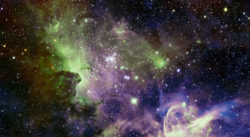





1 Comment
UFO Insight does not take responsibility for the content of the comments below. We take care of filtering profanity as much as we can. The opinions and discussion in the comments below are not the views of UFO Insight, they are the views of the individual posting the comment.
Newest comments appear first, oldest at the bottom. Post a new comment!
Similar planet